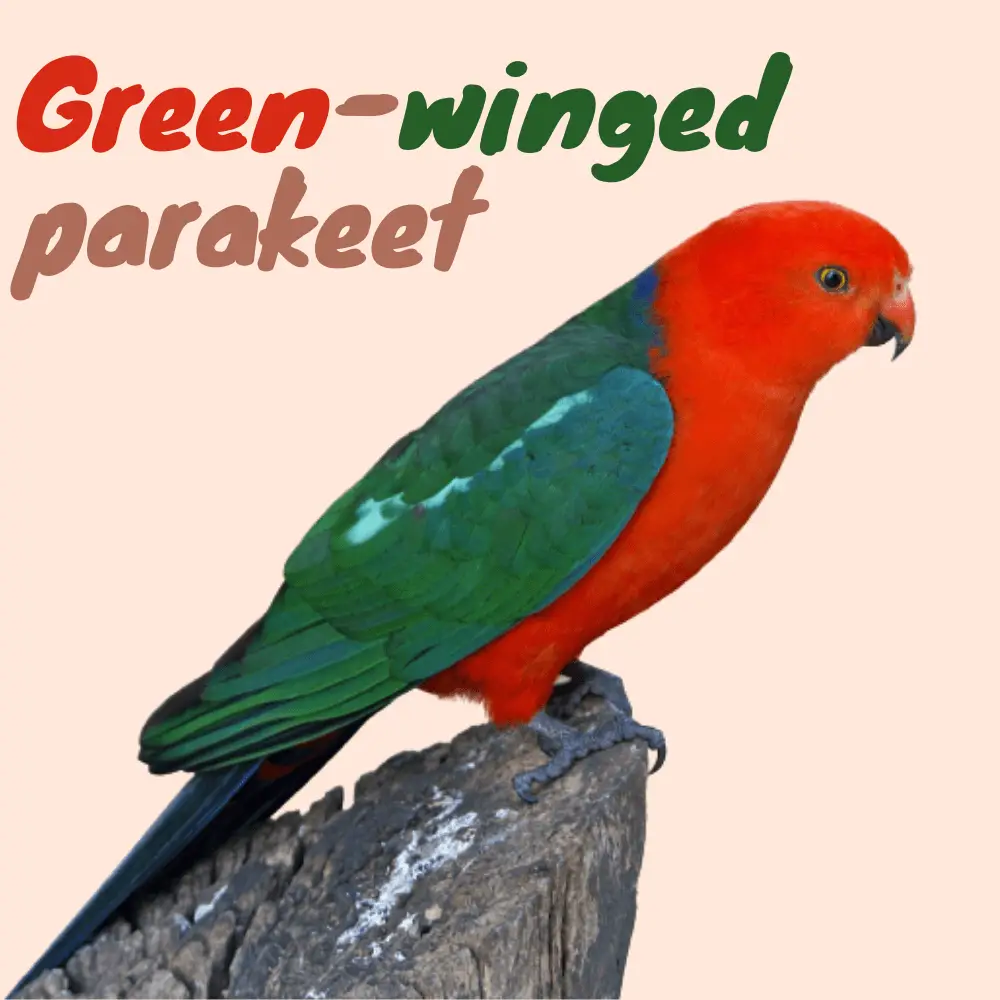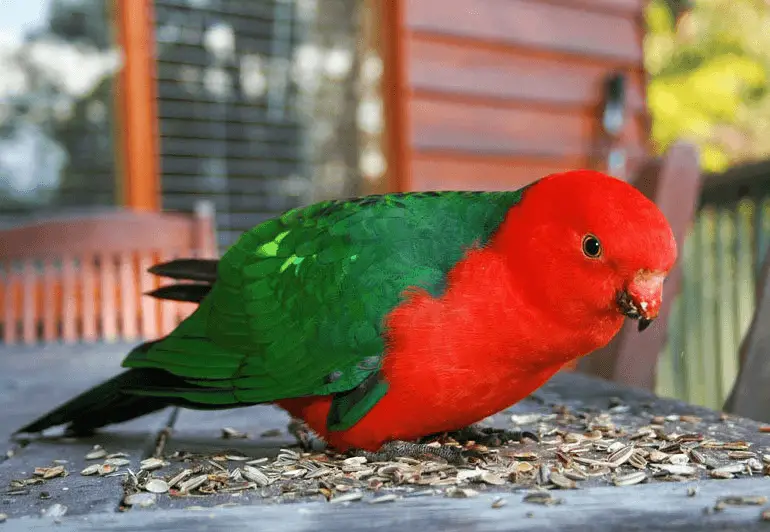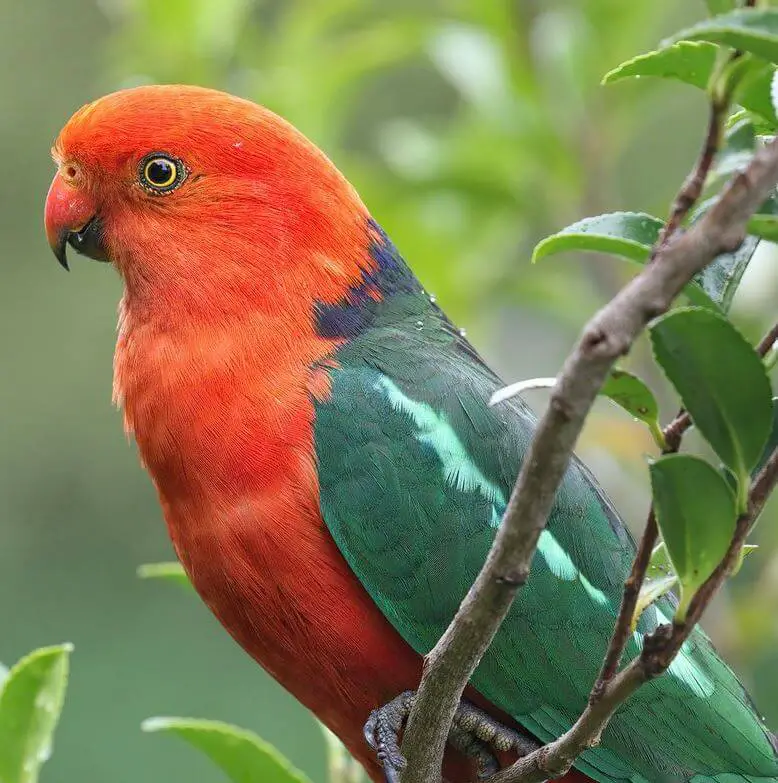
The Green-winged Parakeet ( Alisterus chloropterus ) is a species of bird belonging to the family of Psittacidae.
Reign: Animalia.
Branch: Chordata.
Sub-branch: Vertebrate.
Class: Aves.
Order: Psittaciformes.
Family: Psittacidae.
Kind: Alisterus.
Latin name: Alisterus chloropterus.
Subspecies
According to the reference classification (version 5.2, 2015) of the International Ornithological Congress, this species consists of the following three subspecies ( phylogenic order ):
A. c. moszkowskii (Reichenow, 1911);
A. c. callopterus (D’Albertis & Salvadori, 1879);
A. c. chloropterus (Ramsay, 1879), inhabiting eastern New Guinea.

Description
This species looks a lot like the Royal Parakeets and the Amboyna Parakeet but it is, with its 36 cm long, slightly smaller than the latter. The male and the female are differentiated by a magnificent sexual dimorphism.
Indeed the male has the head, the sides of the neck, and the entire underside of the body entirely scarlet red.
Its nape, back, rump, and tail-coverts are blue-purple while its scapulars, inner wing-coverts, and mantle are greenish-black, and its lesser and middle wing-coverts form a yellow-green mirror.
The rest of the wings, bastard, primaries, and secondaries are dark green with almost black interior mirrors and the upper cover of the large tail feathers is blue-black and the underside is grey-black.
The upper mandible is orange-red at the base to gradually become gray-black going towards the tip while the lower one is gray-black, the irises are orange.
The legs are gray and the nails are gray-black. In contrast, the female has a dull green head, nape, lateral parts of neck, back, rump, wings, and tail-coverts.
Throat and upper breast are more olive green, with small brownish-red edges to upper breast feathers, whereas the rest of the lower body is scarlet.
The delineation of the colors of the chest is very clear and goes from one roundness of the shoulder to the other. The greater tail-coverts seen from above are dark green and almost tipped black.
The underside of the tail is grey-black. The base of the upper mandible of the beak is dull red-brown. The rest of his body is identical to the male’s. We can meet several subspecies of the Royal Green-winged Parakeet:
The Alisterus chloropterus Minkowski or ” Moszkowski’s green-winged parakeet” lives in northern New Guinea. Its Male is identical to the nominal form but the violet-blue of the upper mantle is replaced by dark green.
This purple-blue can still be seen marginally on some females. The back and mantle have a green color that ranges from dark green to a greenish-black tint and small dark green feathers can be seen on either side of the chest. On the other hand, the female is identical to the species.
The Alisterus chloropterus callopterus or ” Salvadori’s green-winged parakeet. ” living in central New Guinea. The Male is identical with however the blue-violet field of the nape reduced to a narrow band at the top of the mantle and a scarlet neck.
The female is identical to the species.
Habitat
This species lives in the eastern part of New Guinea where it is common, especially in Papua. This bird inhabits dense forests up to 2,800 m altitude.
Distribution
This species lives in the eastern part of New Guinea where it is common, especially in Papua.

Enclosure and Aviary
Uncommon in captivity, it was only presented in a few parks in Europe, America, and Asia, but rarely reproduced. The species should be kept in pairs in an outdoor aviary backing onto a room that can be heated.
The outdoor aviary should be located in a semi-shaded place and its optimal dimensions are as follows: 6 x 1.5 x 2 m. If they are installed in smaller volumes, the Green-winged Royal Parakeets tend to quickly become fat and listless.
The ambient temperature during the acclimatization period should be at least 20° C and the air humidity should be quite high. Once the birds have gotten used to our climate, the temperature inside the room can go down to 5°C.
The Green-winged Royal Parakeets are unconditional followers of the shower, the installation of a ramp/shower is therefore necessary.
Lifespan
This species can live for about 25 years.
Behavior
The Royal Green-winged Parakeet is naturally a placid species, it is only during the breeding period that it becomes more aggressive, it is even possible to note an increase in intolerance between the partners of the couple at this period. of the year.
The call is quite loud. Vigilant control must be exercised over the aggressiveness expressed by birds, especially in the early morning and late afternoon. If necessary separate the two partners and install them in neighboring aviaries which they can see.
Food

The Royal Parakeet requires a lot of fruits and vegetables during acclimatization as well as sprouted and semi-ripe seeds such as corn and green seeds of oats and wheat on the cob.
She will also appreciate a mixture of seeds for large parakeets. Outside breeding, a portion of ground egg food is given twice a week.
Do not forget to put grit, gravel to aid digestion, and fresh water at the disposal of the residents. During reproduction, also remember to give food for thin beaks. In their natural environment, they will hunt in forests, orchards, and crops of fruits and cereals necessary for their health.
Reproduction
The hardest part of breeding this species is the fact that the birds choose their mate themselves and will not accept a mate by force, such as specimens that have had the opportunity at a young age to choose themselves. even one partner will have the best chance of reproducing.
The Royal Green-winged Parakeet does not mature until late, in fact from the age of seven years for males and six for females.
Forming a pair from birds in breeding conditions is not without risk and can end tragically. It is advisable, even necessary, to exercise close control several times a day to be aware of the evolution of things.
The Royal Green-winged Parakeet will settle in a natural nest box with a cavity having a diameter of 25 cm and a depth ranging from 1.2 m to 1.8 m. Installing multiple nesting boxes in your aviaries can increase your chances of breeding.
The bottom of the nest box is lined with groundwood shavings forming a layer of about 6 cm. Egg-laying usually begins in May and the female lays an egg every two days so that she can hatch two or three.
It incubates alone for about twenty days and the young remain in the nest for six to eight weeks. They still depend on their parents for three to four weeks after fledging.
Status in the Natural State
The Royal Green-winged Parakeet, all species combined, is very rare in captivity. The private collections around the world holding it can be counted on the fingers of one hand. This species is classified on the IUCN list as Least Concern.





















